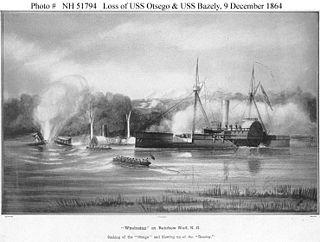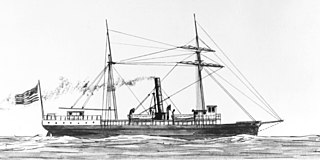| History | |
|---|---|
| Name: | USS Commodore Jones |
| Acquired: | 1863 |
| Commissioned: | 1 May 1863 |
| Struck: | 1864 |
| Fate: | Sunk by electric mine 6 May 1864 |
| General characteristics | |
| Type: | Gunboat |
| Displacement: | 542 long tons (551 t) |
| Length: | 154 ft (47 m) |
| Beam: | 32 ft 6 in (9.91 m) |
| Draft: | 11 ft 8 in (3.56 m) |
| Propulsion: |
|
| Speed: | 12 kn (14 mph; 22 km/h) |
| Complement: | 88 |
| Armament: | 4 × 9 in (230 mm) smoothbore guns, 1 × 50-pounder rifle, 2 × 30-pounder rifles, 4 × 24-pounder guns |
USS Commodore Jones (1863) was a ferryboat acquired by the Union Navy during the American Civil War. Ferryboats were of great value, since, because of their flat bottom and shallow draft, they could navigate streams and shallow waters that other ships could not.

The Union Navy was the United States Navy (USN) during the American Civil War, when it fought the Confederate States Navy (CSN). The term is sometimes used carelessly to include vessels of war used on the rivers of the interior while they were under the control of the United States Army, also called the Union Army.

The American Civil War was a war fought in the United States from 1861 to 1865, between the North and the South. The Civil War is the most studied and written about episode in U.S. history. Primarily as a result of the long-standing controversy over the enslavement of black people, war broke out in April 1861 when secessionist forces attacked Fort Sumter in South Carolina shortly after Abraham Lincoln had been inaugurated as the President of the United States. The loyalists of the Union in the North proclaimed support for the Constitution. They faced secessionists of the Confederate States in the South, who advocated for states' rights to uphold slavery.

The draft or draught of a ship's hull is the vertical distance between the waterline and the bottom of the hull (keel), with the thickness of the hull included; in the case of not being included the draft outline would be obtained. Draft determines the minimum depth of water a ship or boat can safely navigate. The draft can also be used to determine the weight of the cargo on board by calculating the total displacement of water and then using Archimedes' principle. A table made by the shipyard shows the water displacement for each draft. The density of the water and the content of the ship's bunkers has to be taken into account. The closely related term "trim" is defined as the difference between the forward and aft drafts.
Contents
- Purchased in New York City in 1863
- Civil War operations
- Assigned to the North Atlantic Blockade
- Commodore Jones strikes a mine and sinks
- See also
- References
She was outfitted by the Union Navy as a heavily armed gunboat and assigned to the blockade of the waterways of the Confederate States of America.

A gunboat is a naval watercraft designed for the express purpose of carrying one or more guns to bombard coastal targets, as opposed to those military craft designed for naval warfare, or for ferrying troops or supplies.

The Confederate States of America, commonly referred to as the Confederacy and the South, was an unrecognized country in North America that existed from 1861 to 1865. The Confederacy was originally formed by seven secessionist slave-holding states—South Carolina, Mississippi, Florida, Alabama, Georgia, Louisiana, and Texas—in the Lower South region of the United States, whose economy was heavily dependent upon agriculture, particularly cotton, and a plantation system that relied upon the labor of African-American slaves.












